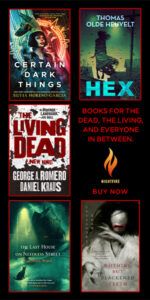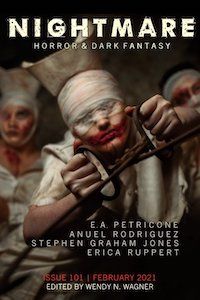Launched in 2019, Nightfire, the new horror imprint from Tor, encompasses the breadth of horror, from short story collections to novellas and novels, from standalone works to series, from dark fantasy to the supernatural, from originals to reprints of lost modern classics. Nightfire’s novels are now appearing on shelves in bookstores and libraries near you. Do you dare stretch the spines on these terrifying titles this autumn?
Healing With Horror
Horror in any medium of art, is more than just fun and scares. Horror is an apt tool for social commentary, and high-octane emotions such as grief and revenge. There is a reason I go back to reading Edith Wharton’s ghost stories, Shirley Jackson’s The Haunting of Hill House, and Tananarive Due’s brilliant collection Ghost Summer. There is something about such works that heal as well as horrify. There is beauty and recovery in coming out the other end of a dark read. Wendy Wagner, editor of the horror literary magazine Nightmare, wrote in her February 2021 issue editorial, “I’ve escaped unhappiness by diving into the thrills of countless monstrous adventures; I’ve felt my will to live return after a good jump scare — and I’ve found tremendous insight into the human condition in the work of horror creators across all mediums. Horror and dark fantasy offer us an amazing realm to learn about ourselves, our fellow humans, and our relationship to the world.”
Whispers & Howls in Horror Literary Magazines
I want to highlight a couple exceptional horror stories and honor horror magazines and the great work they publish. Many of the mentioned literary magazines feature gothic stories, ghost stories, and stories of the afterlife and gruesome murders. For horror writers, this is an opportunity to soak in more publications to get a sense of their style. For readers, tuck yourself in by a well-lit lamp. Read and weep, or read and scream. Some stories are a whisper, and other are a howl. Let’s begin. Such a howl of a story can be found in “We, the Girls Who Did Not Make It” by E.A. Petricone in Nightmare Magazine. Told by the many victims of a group of serial killers, it is about the need to escape a place of violence, and saving those who might be next. It is a coming together of ghosts and grief, and the collective urge to break the cycle of violence. The writing is cutthroat and raw, building the tension to a fever pitch ending. A whisper of a horror story, thick with the eeriness of the afterlife, can be found in “The Shadowed Undertows,” by Natalia Theodoridou in The Deadlands. There is such quiet, unsettling imagery in this story, from birds flying backwards to the dead rolling their own tombstones. It gives a whole new perspective to the phrase “six feet under” and I don’t think I’ll ever look at graves the same way again. Not that girls are ever protected, but we are dead, so let us have this.” In addition to the brilliant imagery, there is an exquisite layer of emotion — sadness, regret, loneliness — as thick as fog. This story may not strike many readers as scary, but it is unsettling, atmospheric, and haunting.
Quick Screams: Flash Fiction in Horror Literary Magazines
For a quick bite of scares, I encourage you to look to flash fiction, which usually falls under 1,000 words. There are publications that specialize in flash fiction, such as Pseudopod‘s flash episodes, Flash Fiction Online, and others, while other horror magazines offer the full range of lengths, from flash fiction to novellas. These are great stories for when you want to dip into horror without staying there too long, though the stories may haunt your thoughts long afterward. He stands next to me, our shoulders touching. He smells exactly as I remember — clean skin, morning rain, a hint of lemons — and, finally, I can tell. ‘It just forgot,’ he says. ‘That’s all.’” I had the great honor of having my own horror flash published in the same episode of Pseudopod as Eugenia M. Triantafyllou’s “Cherry Wood Coffin,” which was originally published in Apex Magazine. It’s a quiet, haunting flash about a coffin-maker, the duty to keep the dead at rest, and the consequence when that law is not followed. For a flash story, it is filled with hints of a world beyond that will have the reader salivating for more of this author’s work (you’ll find much more great work from Triantafyllou in Uncanny). It is a heartbreaking piece, beautiful and pointed in its language. To highlight Nightmare again with a story that just straddles the fence of flash fiction, at about 1,200 words, “Still Life with Vial of Blood” by Nelly Geraldine García-Rosas is a story that builds and builds on discomfort. By the time you reach the end, it’s almost impossible not to go back and reread it, daring yourself to look again. It’s a story structured as a list of artwork with footnotes, which are listed in sequence at the very end. A brilliant, chilling story where every sentence and visual has a purpose. I can’t stop thinking about this story. The coffin whispers louder and more coherently as the days pass.”
Thirsty for More Horror?
To list all the great stories out there being published in horror literary magazines would take many more words. Suffice to say that horror is a strong and healthy monster in the literary magazine world, though there is always room for more. In addition to the stories and magazines featured above, check out the links listed in the introduction to other horror literary magazines as well as the following publications that also publish horror, dark fantasy, and overall dark fiction:
Apex MagazineFantasy MagazineLightspeedTor.comBlack StaticLamplight
To further quench your thirst for good horror reads, I recommend checking out fellow Book Rioters K.W. Colyward’s The Best Horror Books of the Decade and Jessica Avery’s I Stuck a Book In My Freezer: Resources for New Horror Readers. If the above featured stories don’t strike your dark fancies, then I assure you, other stories in the above listed publications will have something to stir your blood. So find a warm blanket and tuck yourself in. Your adventures into the horror short form have only begun.



